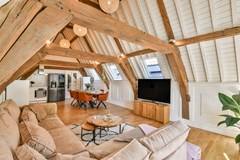The popularity of new construction compared to existing buildings

Houses from the 1930s have long been a favorite in the housing market. Pre-war houses are known for their characteristic appearance with bay windows, en-suite doors, stained glass windows, and ornate high ceilings. The demand for these houses is declining, but there is a shift in progress. In general, the popularity of new construction houses compared to existing buildings is visibly increasing. There is a simple explanation for this: buyers are now more than ever considering energy costs.
Energy-neutral new construction houses are popular
Houses from the 1930s are generally not known for their energy-efficient characteristics, and this is also lacking in other old existing buildings. With new construction, there are perfectly insulated homes, and there are also new projects with energy-neutral homes. This is beneficial for homeowners because they no longer receive an energy bill. In such new construction projects, there is often a combination of sustainable measures such as solar panels, heat pumps, and heat recovery ventilation.
The demand for new construction homes is increasing because there are no or lower energy costs. Furthermore, new construction homes also provide optimal comfort in terms of temperature and indoor climate. Additionally, new construction homes are subject to minimum requirements under the building code. This means that a minimum energy label of A, the most energy-efficient label, applies to new construction. In addition, new construction homes are often even more energy-efficient than existing homes with an energy label A.
New trend: more attention to energy labels
The demand for new construction is high, but the supply is limited. Due to high prices, it is almost impossible for first-time buyers to purchase a new construction home. The demand for existing buildings remains, but with a focus on the energy label. The Dutch Association of Realtors is conducting research into the increasing attention of homebuyers to the energy label.
Funda has also observed this trend and states that the majority of potential buyers now pay attention to the energy label. The filters are no longer only active for price and location but also for the energy label. Homebuyers are also increasingly interested in the energy contract associated with a home. The energy label, combined with the energy contract, is now a factor that weighs in negotiations over the purchase price.
Renovated and sustainable existing buildings in demand
There is a shortage of new construction homes, and for financial reasons, some people cannot buy a new construction home. Therefore, a large group is still reliant on existing buildings, with renovated and sustainable homes being the most popular. This is due to a favorable energy label, with a focus on insulation measures and sustainable installations.
Self-insulating existing buildings: replacing single glazing
The group of potential buyers who cannot afford to buy a new construction or energy-efficient existing home is left with existing buildings, with the option to implement insulation and sustainability measures themselves. There are still old houses, some of which are partially fitted with single glazing. When buying such a home, it is essential to replace single glazing with double glazing or triple glazing, such as HR+++ glass. Simply replacing single glazing with HR++ glass can save 24 cubic meters of gas per square meter. HR+++ glass offers even higher savings. Besides thermal insulation, double or triple glazing also provides additional living comfort and, in addition to thermal insulation, offers acoustic insulation.
Installing solar panels
One advantage of buying an old, poorly insulated home is that there is room for negotiation on the asking price. Especially now that the energy label plays a more prominent role in home purchases, this strengthens the negotiating position. Older and poorly insulated homes are often cheaper than recently renovated existing buildings or new construction. This provides opportunities to buy the home and then implement insulation measures yourself. For example, it is possible to install solar panels to reduce energy costs.
Gas-free home with a heat pump
Existing homes can also be equipped with a heat pump to make the house gas-free. The central heating boiler can be replaced, and cooking can be done with electricity. It is essential that there is room in the immediate vicinity to install a heat pump. A hybrid heat pump also requires space for an outdoor unit. Moreover, it is crucial that the rest of the house is well-insulated, as this helps to retain heat better.
Old homes are often poorly insulated, such as 1930s homes. In such cases, heat is lost more quickly. Therefore, it is advisable to insulate both roofs and exterior walls to make the most of the heat pump's efficiency. It is often less profitable to install a heat pump in a non-insulated pre-war home. If a house does not have insulated cavity walls, the insulation value is low.
Insulating pre-war homes
1930s homes are currently less popular than new construction, but this does not mean that their popularity has completely disappeared. It is merely necessary to have a substantial amount of money available to insulate a pre-war home. There are, of course, plenty of options to insulate old pre-war homes, such as floor insulation, roof insulation, and facade insulation. When insulating such homes, it is also essential to pay attention to details and seal gaps and cracks. Sealing gaps reduces drafts in the home and reduces heat loss.
Buying or selling a house?
The sustainability of homes is playing an increasingly important role in the buying and selling process. It is now a factor in determining property value. If you want to buy or sell a house in Amsterdam or the surrounding area, it is essential to consider all aspects. Amstelland Makelaars is here to take care of these concerns and offers targeted support for a successful purchase or sale.











